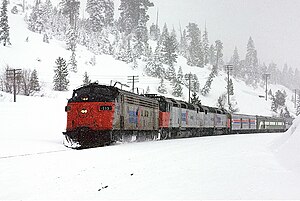EMD F-unit
Longer EMD E-units for passenger service had twin 900-horsepower (670 kW) diesel engines (called "prime movers" in that type of application).
Almost all F-units were B-B locomotives, meaning that they ran on two Blomberg B two-axle trucks with all axles powered.
The prime mover in F-units was a sixteen-cylinder EMD 567 series mechanically aspirated two-stroke diesel engine, progressing from model 16-567 through 16-567D.
The so-called bulldog nose was a distinguishing feature of the locomotive's appearance, and made a lasting impression in the mind of the traveling public.
The FT, introduced in 1939 with the new 1,350 hp (1.01 MW) 567 engine and Blomberg B trucks, was a successful design, and remained in production during WWII.
Only one F model did not have Blomberg B trucks: the FL9 electro-diesel locomotive had a lightweight Flexicoil B in front and a standard passenger A-1-A at the rear.
EMC/EMD built all of its major components after 1939[3][4] While the F-unit series was originally conceived for freight service, many were used to haul passenger trains.
The AT&SF Super Chief, CB&Q/D&RGW/WP California Zephyr, and GN Empire Builder all used F units on their Chicago-West Coast routes in the 1950s.
Dynamic brakes were an option on F units ordered by railroads operating in mountainous terrain and with steep grades.
The freight pilot curves inward a little way below the bottom of the nose before sloping out again, to give more clearance to the coupler and hoses.

